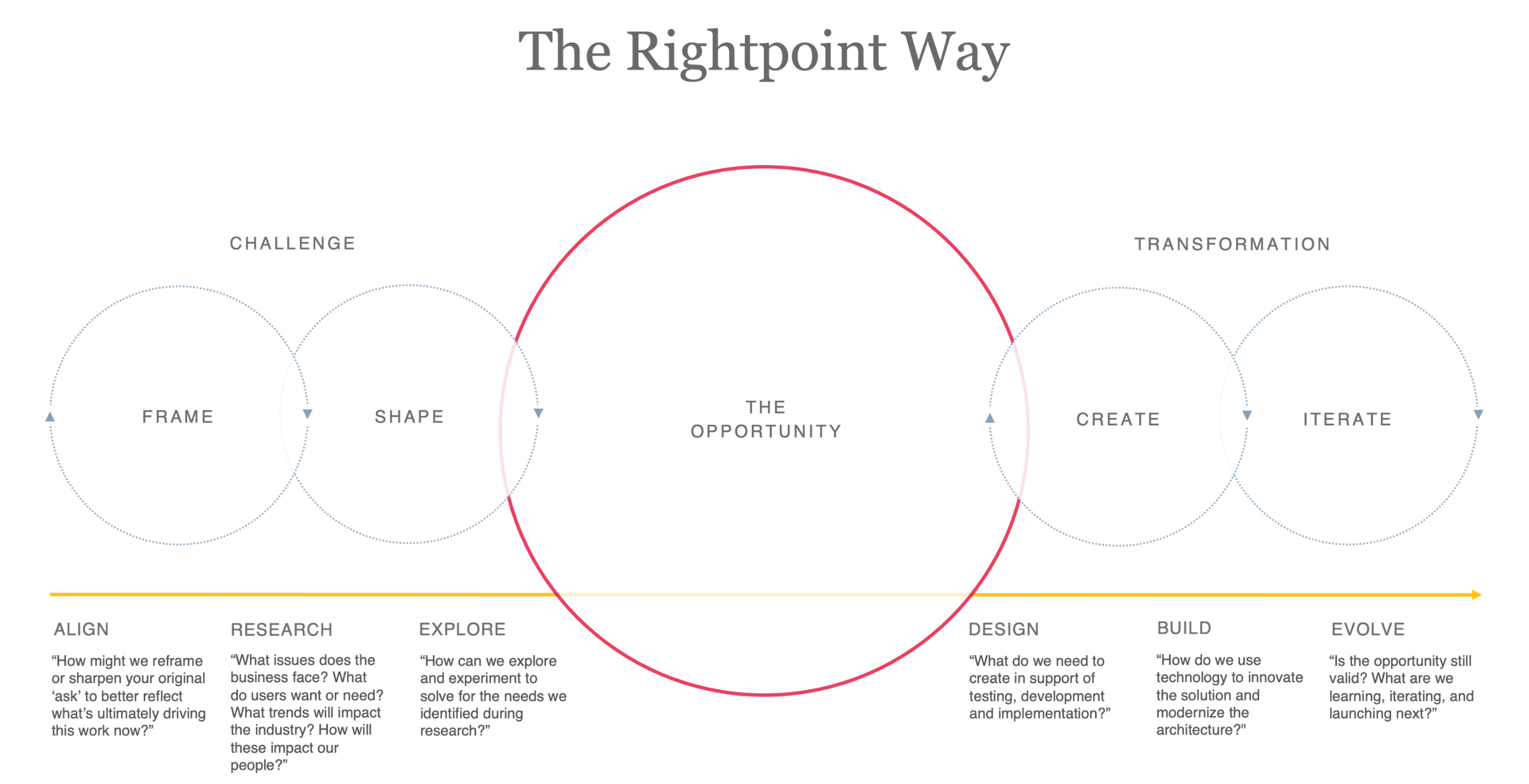
Power the Pivot: How to Innovate with Research and Strategy
As a people nerd and history buff, I’m often reminded of a quote from Albert Einstein, who famously professed, “If I had an hour to solve a problem, I’d spend 55 minutes thinking about the problem and 5 minutes about the solutions.” This principle holds true when any client comes to us with a challenge. In order to identify opportunities for clients to innovate, it’s crucial to gain a holistic understanding of the problem through the lens of the business (viability), technology (feasibility), and people (desirability).


Many companies today are faced with a common question: how can we improve what we’re currently doing to meet consumers’ demands? This question has only risen in importance since the onset of COVID-19, and many organizations are struggling to find an answer. Companies are seeking a desired outcome that will grow the business, provide an exceptional customer experience, and increase profits, and we understand how nuanced these challenges can be.
How can companies tackle this question in a meaningful way that creates both short- and long-term opportunities? How can they be sure that they’re tackled in the right order? There are multiple ways to answer these questions, and each begins with research.
In this piece, the first in a two-part series, we’re going to look at how research provides clarity on human-centered solutions to business and customer experience problems to help drive innovation. This is followed by an in-depth look at how we propel insight into action using strategic frameworks to prioritize opportunities into a roadmap, equipping businesses with a clear path forward.
Research is Risk Reduction
At its core, Customer Experience begins with a deep understanding of the needs, wants, and behaviors of people, all of which are evolving rapidly today. This is why we often begin this process with a human focus. Since we’ve entered the Experience Economy, brands have been competing for market share. This is a trend over the past several years that has only accelerated due to the pandemic. Subsequently, the economic situation is more volatile, and businesses are seeing how quickly they need to adapt to new situations to stay alive and thriving.
With budgets tightening across organizations, there may be a tendency to cut spend on market and consumer research in favor of operational or capital expenses. However, we believe this is the time businesses need to invest in more research to understand their users, not less. As Katie Moran, User Experience Specialist with Nielsen Norman Group, simply states, “user research is a form of risk reduction, and the greater the risk (for example, because of rapid change), the more you need that risk reduced.” We’re witnessing that only companies nimble enough to adapt sustainably can keep up with the pace of changing market, consumer demands, and technology.
Let’s walk through an example of how we recently worked with a national retailer, leveraging consumer insights to re-imagine their overall omni-channel experience.
Customer Spotlight
Context: A specialty retail chain asked Rightpoint to expand its understanding of customers' current omnichannel experience to inform a technical and design roadmap that would improve customer retention and brand advocacy.
For over 60 years, this national retailer has provided its customers with specialty, imported goods at affordable prices across its +250 locations. While they built a rapport and were very knowledgeable of their in-store and loyal rewards shoppers, there were gaps in their understanding of customers who see the brand across different touchpoints. This became problematic as they expanded their digital presence.
With technological advances and data-driven experiences, forward-thinking retailers are setting the bar high, posing challenges to companies with a brick and mortar presence. As a result, consumers’ expectations have shifted dramatically in the retail space.
More specifically, our client was faced with different, yet connected challenges including: brand identity inconsistencies across channels, siloed shopping experiences from in-store to online, and technical limitations of their current ecommerce platform. Such limitations made it difficult for prospective and lapsed customers to understand their differentiated positioning in the retail market, hindering customer retention and brand advocacy.
Fig 1.

Using the Rightpoint Way methodology—Frame, Shape, Create and Iterate—we leveraged a mixed-methodology research approach working in tandem with the analytics and insights team at Rightpoint to begin understanding their customer and prospective audiences in more depth. We paired qualitative insights gleaned from customer interviews, in-store intercepts, usability testing, and surveys with complex transactional and website analytics data to tell a more rich, contextual story about the client’s customers.
What we were able to learn from speaking with customers was invaluable input for our client and our team. We heard about the moments of delight customers that arise as they walked through the aisles and suddenly discovered the perfect gift to get their friend or eclectic decor to adorn their new home office with. We also often heard stories of frustration, as many disclosed the desire to have a more connected experience as confessed from a long-time customer that, “in-store is a personal driven experience...I would want to see a customer profile to recommend more items to explore the website and see everything there is to offer.” Additionally, we learned about confusion around pricing, sales policies and the rewards program offerings. And for prospects, many were unsure of what they have to offer all together. Needless to say, the lessons learned from this phase of work gave us insight into our clients’ current obstacles of having a seamless, unique omnichannel experience.
Customer Empathy and Action
After completing customer research, we defined core guiding CX principles that would serve as our foundation and approach to craft three distinct customer journeys aligning with customer and acquisition audience types including: prospective customers and lapsed members, active rewards members, and non-rewards customers.
The customer journeys served as a tool for our team to garner an intimate understanding of customer empathy. This helped us identify near-term wins, driving improvements on the current site, while concurrently informing the future digital customer experience vision.
Overall, the customer journey maps identified 46 opportunities to convert the pain points of the current customer journey to a frictionless, future-state omnichannel experience. Now, it was time to pair our customer learnings with business goals and technical requirements to determine a tactical roadmap instructing the client on what it would take to develop a future state shopping experience.


